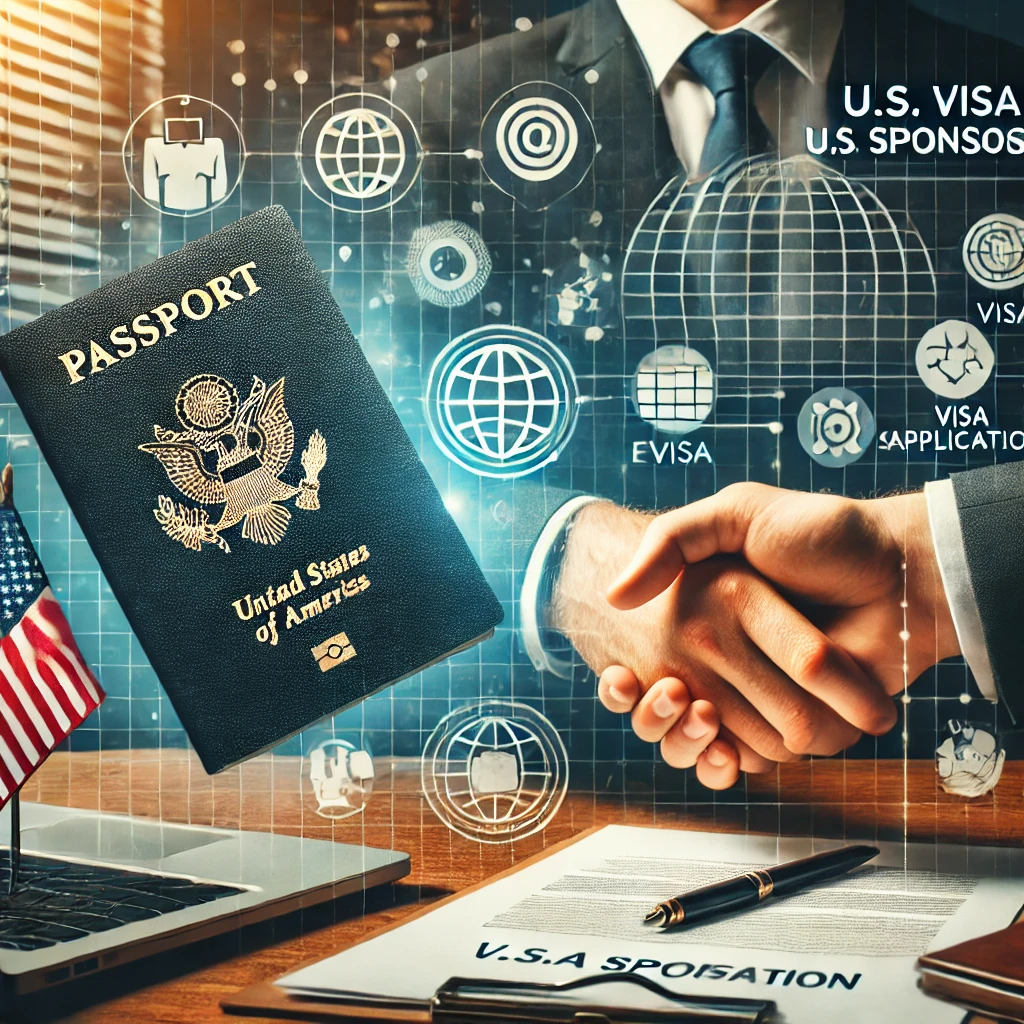U.S. Visa Sponsorship For Immigrants. Securing a U.S. visa sponsorship can be a game-changer for professionals seeking to work and live in the United States. As the world’s largest economy, the U.S. offers incredible opportunities across many industries for foreign nationals with the right skills and qualifications. However, the process of getting a visa sponsorship can be daunting and highly competitive.
In this comprehensive guide, we will break down the types of visas available, the visa sponsorship process, eligibility criteria, and strategies to find companies that are willing to sponsor foreign workers. Additionally, we’ll cover important topics like the cost of visa sponsorship, required documentation, and the value of hiring an immigration attorney to help you navigate this process. Let’s dive into the world of U.S. visa sponsorship and help you set yourself up for success in 2024.
1. Introduction to U.S. Visa Sponsorship
Visa sponsorship is essential for foreign nationals who want to work, live, or study in the United States. This sponsorship means that a U.S.-based organization, employer, or individual is responsible for the visa application of a foreign national, advocating for their legal entry into the country. Essentially, the sponsor provides assurance that the foreign national will adhere to U.S. immigration laws and be financially supported if necessary.
There are several types of visa sponsorship, ranging from family-based sponsorship (for spouses, children, or relatives) to employment-based sponsorship (for professionals, skilled workers, and researchers). Employment-based sponsorship is one of the most common pathways for foreign professionals looking to secure long-term residency in the U.S. This form of sponsorship often requires the employer to prove that there is no qualified U.S. worker available to fill the job position, ensuring that the visa is issued only to those with specialized skills or expertise that are in short supply domestically.
Visa sponsorship can be complex and time-consuming, but for many, it is the key to unlocking new opportunities and career growth in the U.S.
2. Types of U.S. Employment-Based Visas
There are several employment-based visa categories available for foreign nationals, depending on their qualifications, experience, and the job they are applying for. Below are the most common visa types that require sponsorship.
H-1B Visa: For Specialty Occupations
The H-1B visa is perhaps the most popular employment visa for foreign professionals working in specialty occupations, including technology, engineering, healthcare, and finance. This visa allows U.S. employers to hire foreign workers in roles that require specialized knowledge and at least a bachelor’s degree or its equivalent.
- Annual Cap: Each year, 65,000 H-1B visas are issued, with an additional 20,000 reserved for applicants with advanced degrees from U.S. institutions.
- Eligibility: The applicant must possess a bachelor’s degree or higher in the specific field required for the job, and the employer must demonstrate that the role cannot be filled by a qualified U.S. worker.
- Limitations: The H-1B is subject to an annual lottery due to the high demand for this visa, and it is valid for an initial period of three years, which can be extended up to six years.
L-1 Visa: For Intracompany Transfers
The L-1 visa is designed for employees of multinational companies who are being transferred to a U.S. office. It is divided into two categories:
- L-1A: For executives and managers.
- L-1B: For employees with specialized knowledge.
The L-1 visa allows companies to move highly skilled employees from their overseas offices to the U.S. without being subject to an annual cap, making it a faster alternative to the H-1B.
Key Benefits:
- There is no lottery system, and there is no cap on the number of L-1 visas issued.
- L-1 visas can lead to permanent residency through the EB-1C employment-based green card category.
O-1 Visa: For Individuals with Extraordinary Ability
The O-1 visa is intended for individuals with extraordinary abilities or achievements in fields such as arts, sciences, business, athletics, or education. To qualify, applicants must provide evidence of significant achievements in their field and sustained national or international acclaim.
- Eligibility: The O-1 visa is typically granted to individuals who can provide substantial proof of their achievements, such as awards, published works, or membership in prestigious organizations.
- Application Process: Employers must file a petition with USCIS on behalf of the applicant.
TN Visa: For Canadian and Mexican Professionals
The TN visa is available for Canadian and Mexican citizens under the United States-Mexico-Canada Agreement (USMCA), formerly NAFTA. It is specifically designed for professionals in designated fields, including law, engineering, accounting, healthcare, and education.
- Benefits: The application process is relatively simple, and TN visas can be renewed indefinitely.
- Eligibility: Applicants must hold at least a bachelor’s degree and meet specific requirements for their profession.
EB-3 Visa: Employment-Based Third Preference Visa
The EB-3 visa allows professionals, skilled workers, and unskilled laborers to secure employment in the U.S. It is ideal for those with job offers from U.S. employers and is often used by those with lower educational qualifications than H-1B applicants.
- Eligibility: Applicants must have a permanent job offer and the employer must prove that no qualified U.S. worker is available for the position.
- Advantages: This visa provides a pathway to permanent residency (green card).
Transactional Keywords: “EB-3 visa application,” “sponsor EB-3 visa,” “employment visa for skilled workers.”
3. Understanding the Visa Sponsorship Process
The visa sponsorship process can be complex, involving multiple stages that require collaboration between the employer, the foreign national, and U.S. Citizenship and Immigration Services (USCIS). Below is a step-by-step breakdown of the typical process:
Step 1: Employer Files a Petition
For most employment-based visas, the sponsoring employer must first file a petition with USCIS. This petition, such as the Form I-129 for the H-1B visa, outlines the employer’s intent to hire a foreign worker and demonstrates that the job cannot be filled by a qualified U.S. worker. This step also involves the Labor Condition Application (LCA), where the employer certifies that hiring the foreign worker will not negatively affect U.S. workers’ wages and working conditions.
Step 2: Employee Applies for a Visa
Once the employer’s petition is approved by USCIS, the foreign national can then apply for a visa at a U.S. embassy or consulate in their home country. During this step, the applicant must submit necessary documentation, such as their passport, educational transcripts, job offer letter, and financial statements.
Step 3: Visa Interview
Most applicants will be required to attend a visa interview at the U.S. embassy or consulate. During this interview, consular officers will assess the applicant’s qualifications, the legitimacy of the job offer, and the applicant’s intent to comply with the terms of the visa.
Step 4: Visa Approval
Once approved, the foreign national will receive their visa, allowing them to enter the U.S. under the terms of their employment-based visa.
4. Key Eligibility Requirements for Visa Sponsorship
Visa sponsorship eligibility depends largely on the type of visa being applied for and the qualifications of both the applicant and the sponsoring employer. Here are some of the common requirements:
Educational Qualifications
For most employment-based visas, including the H-1B, applicants must have at least a bachelor’s degree in a relevant field. In cases like the O-1 visa, where extraordinary ability is required, formal education may be less important than demonstrating exceptional achievements in your field.
Work Experience
Many visas, such as the L-1 and O-1, require applicants to have several years of relevant work experience. For the L-1 visa, this experience must be gained while working for the sponsoring employer in an overseas office.
Sponsoring Employer Requirements
Sponsoring Employer Requirements For the employer to successfully sponsor a foreign worker, they must meet several key requirements:
- Legitimate Job Offer: The job offer must be for a legitimate position that requires specialized knowledge, and the employer must prove that no qualified U.S. workers are available to fill the role.
- Labor Condition Application (LCA): Employers sponsoring H-1B workers must file an LCA with the Department of Labor (DOL), certifying that hiring the foreign worker will not negatively impact the wages and working conditions of U.S. workers in similar positions.
- Ability to Pay: Employers must demonstrate that they can pay the prevailing wage for the job offered to the foreign worker. This is particularly important for H-1B, L-1, and EB visas.
5. High-Demand Industries for U.S. Visa Sponsorship
Visa sponsorship is most prevalent in industries experiencing a shortage of domestic talent. Let’s explore some of the industries with the highest demand for foreign professionals.
1. Technology
The tech sector in the U.S. continues to lead the way in hiring foreign professionals through visa sponsorship, particularly through the H-1B visa. Major companies like Google, Microsoft, Amazon, and Facebook rely heavily on foreign talent to fill roles in software development, data science, cybersecurity, and artificial intelligence.
- H-1B Visa Dominance: The tech industry accounts for a significant portion of all H-1B visa applications, as companies continually seek top talent from across the globe to drive innovation and growth.
- High Salary Potential: Tech companies offer some of the highest salaries to visa-sponsored employees, with annual salaries often exceeding $100,000.
2. Healthcare
The U.S. healthcare sector faces an ongoing shortage of skilled professionals, leading to a high demand for foreign doctors, nurses, and specialists. Healthcare employers frequently sponsor H-1B and J-1 visas for foreign medical graduates and researchers.
- Popular Roles: Positions such as physicians, registered nurses, medical researchers, and physical therapists are commonly sponsored through employment-based visas.
- Salaries: Medical professionals often earn high salaries, with doctors and specialists making upwards of $200,000 per year.
3. Engineering
The engineering industry continues to be a leading source of visa sponsorship, particularly for fields like civil, mechanical, electrical, and aerospace engineering. U.S.-based engineering firms and multinational corporations often use L-1 and H-1B visas to transfer or hire foreign engineers.
- Top Companies: Firms like Boeing, Tesla, General Electric, and Lockheed Martin sponsor a significant number of foreign engineers.
- Job Roles: Common job roles include project engineers, design engineers, and research and development specialists.
4. Education and Academia
U.S. universities and research institutions frequently sponsor foreign professors, researchers, and scholars through H-1B, J-1, and O-1 visas. These institutions seek highly qualified individuals to fill teaching and research positions that advance their academic mission.
- Top Institutions: Ivy League universities like Harvard, MIT, and Stanford sponsor a large number of foreign scholars.
- Average Salaries: Professors and researchers can earn between $60,000 and $150,000, depending on their field and position.
6. Essential Documents for Visa Sponsorship
The visa application process requires careful preparation and submission of multiple documents to prove eligibility and ensure compliance with U.S. immigration laws. Here are the key documents needed for most visa sponsorship applications:
For the Employer:
- Petition for Nonimmigrant Worker (Form I-129): This form is required for employers petitioning for H-1B, L-1, and O-1 visas.
- Labor Condition Application (LCA): For H-1B and E-3 visas, employers must submit this form to the Department of Labor, ensuring that the foreign worker will receive wages that meet or exceed the prevailing wage for their occupation and location.
- Employer’s Financial Statements: Employers may be required to submit financial documentation proving their ability to pay the wages specified in the job offer.
For the Employee:
- Valid Passport: Your passport must be valid for at least six months beyond the intended period of stay in the U.S.
- Educational Transcripts: Official transcripts from your educational institution demonstrating that you meet the qualifications for the job.
- Job Offer Letter: A formal offer letter from the sponsoring employer that includes job details, salary, and duration of employment.
- Proof of Work Experience: Documentation such as employment contracts or letters from previous employers detailing your work experience in the field.
- Medical Examination Results: Depending on the visa category, you may need to undergo a medical examination and submit the results as part of your application.
7. Finding Visa Sponsorship Opportunities
Securing a job with visa sponsorship requires strategic planning and an understanding of the industries and companies that are willing to sponsor foreign professionals. Below are some effective strategies to find visa sponsorship opportunities.
1. Job Boards and Company Websites
Many online platforms specialize in listing jobs with visa sponsorship, allowing you to filter opportunities by visa type and job category. Popular websites include:
- H1BGrader: This website provides insights into companies that sponsor H-1B visas, including success rates and industry trends.
- MyVisaJobs: A job search platform tailored to foreign workers looking for U.S. jobs with visa sponsorship.
You can also visit the career pages of large multinational companies and universities that regularly sponsor foreign workers, such as Google, Microsoft, Facebook, Amazon, and major U.S. universities.
2. Networking and Professional Associations
Building a professional network can help you identify visa sponsorship opportunities that may not be publicly advertised. Attend industry conferences, job fairs, and networking events where employers are actively recruiting foreign professionals. Additionally, joining professional associations related to your field can give you access to exclusive job listings and connections with employers who are more likely to sponsor visas.
3. LinkedIn and Social Media
Leverage professional networking sites like LinkedIn to connect with recruiters and hiring managers in companies that offer visa sponsorship. Ensure your LinkedIn profile is fully optimized with relevant keywords and job titles, and regularly engage with industry-specific groups and discussions.
8. The Role of Immigration Attorneys in Visa Sponsorship
Navigating the visa sponsorship process can be complex, with changing immigration laws and extensive paperwork. Hiring an experienced immigration attorney can help you streamline the process and increase your chances of success.
1. Legal Advice on Eligibility
An immigration attorney can assess your eligibility for various visa types and help determine the best pathway for your career goals. They will advise you on the required qualifications, work experience, and documentation needed for your application.
2. Assistance with Petition Filing
Attorneys assist employers in preparing and submitting petitions to USCIS, ensuring that all necessary forms are completed accurately and in compliance with U.S. immigration laws. They also handle any issues that arise during the petition process, such as Requests for Evidence (RFEs) from USCIS.
3. Avoiding Costly Mistakes
Errors in visa applications or petitions can lead to delays, rejections, or even legal consequences. Immigration attorneys help you avoid these pitfalls by providing expert guidance on legal requirements and documentation.
4. Visa Extension and Green Card Applications
If you are seeking to extend your visa or transition from a temporary work visa to permanent residency (green card), an attorney can guide you through the process and ensure compliance with the latest regulations.
9. Costs Associated with Visa Sponsorship
The cost of visa sponsorship varies depending on the type of visa and the associated legal and filing fees. Both the sponsoring employer and the foreign worker may be responsible for covering different aspects of the cost. Below is a breakdown of typical costs associated with visa sponsorship.
1. Filing Fees
- USCIS Petition Fees: The cost to file Form I-129 for an H-1B visa is $460, while premium processing (for faster application processing) costs an additional $2,500.
- Visa Application Fees: Applicants must pay a non-refundable visa application fee at the U.S. embassy or consulate, which typically ranges from $160 to $190 depending on the visa category.
2. Legal Fees
The cost of visa sponsorship varies depending on the type of visa and the associated legal and filing fees. Both the sponsoring employer and the foreign worker may be responsible for covering different aspects of the cost. Below is a breakdown of typical costs associated with visa sponsorship.
1. Filing Fees
The filing fees for employment-based visas are often the largest upfront cost. Here are some of the typical fees associated with popular visa categories:
- H-1B Visa Filing Fee: The USCIS filing fee for an H-1B petition is $460, but there are other associated costs for employers, such as the ACWIA fee ($750 or $1,500 depending on company size), and the Fraud Prevention and Detection Fee ($500). If employers choose to expedite the process, premium processing adds an additional $2,500 to the cost. The total cost for employers can range from $2,500 to $7,500.
- L-1 Visa Filing Fee: For the L-1 visa, the basic petition fee is $460, with an additional $500 fraud detection fee. If the employer is part of a multinational company, they may also need to pay a $4,500 border security fee for certain employees. The cost of premium processing is also $2,500 for the L-1 visa.
- O-1 Visa Filing Fee: Similar to other employment-based visas, the O-1 visa filing fee is $460, and premium processing is available for an extra $2,500. Employers may also incur legal fees for preparing and submitting the petition.
2. Attorney Fees
Hiring an immigration attorney can significantly increase the cost of visa sponsorship. Legal fees for an employment-based visa sponsorship can range from $1,500 to $5,000 or more, depending on the complexity of the case and the experience of the attorney. Some attorneys charge a flat fee for handling the entire process, while others may charge hourly rates for specific services such as reviewing documents, filing forms, or representing the employer in immigration matters.
3. Other Costs
There are additional costs that employers and foreign workers may need to consider when applying for a U.S. visa:
- Visa Application Fee: Applicants must pay a non-refundable visa application fee at the U.S. embassy or consulate. The cost typically ranges from $160 to $190 depending on the visa category.
- Medical Exam Fees: Some visa categories require a medical examination as part of the application process. These exams are typically conducted by a USCIS-approved civil surgeon and can cost anywhere from $200 to $500 depending on the location.
- Travel Costs: Applicants may need to travel to a U.S. embassy or consulate for their visa interview, which could incur additional travel and accommodation expenses.
10. Conclusion: Maximizing Your Chances of Success
Securing a U.S. visa sponsorship can open doors to numerous professional and personal opportunities. However, the process is often complex and competitive, requiring careful planning, preparation, and persistence. Here’s a summary of key steps to help maximize your chances of success:
1. Research the Right Visa for Your Career
Start by identifying the visa category that aligns with your qualifications and job goals. Whether it’s the H-1B for specialized professionals, the L-1 for intracompany transfers, or the O-1 for extraordinary abilities, understanding the specific requirements of each visa type will help you target the right job opportunities.
2. Target Employers with a History of Sponsorship
Focus on industries and companies that frequently sponsor visas. For example, tech giants like Google, Microsoft, and Facebook are known for sponsoring foreign workers, as are healthcare institutions and engineering firms. Use job boards like H1BGrader and MyVisaJobs to find companies that have a strong track record of visa sponsorship.
3. Optimize Your Application
Ensure your resume and cover letter are tailored to the U.S. job market and highlight the skills and qualifications most relevant to the role. During the visa petition process, be sure to provide complete, accurate documentation to avoid delays or rejections.
4. Consider Consulting an Immigration Attorney
Hiring an experienced immigration attorney can significantly increase your chances of success. Attorneys can help navigate the complexities of U.S. immigration law, ensure that all forms and petitions are properly filed, and represent you or your employer if any legal issues arise.
5. Stay Informed and Persistent
U.S. immigration laws and policies can change frequently, so it’s important to stay updated on the latest developments. Keep networking, attend industry events, and continue applying to companies that offer visa sponsorship. Persistence is key in the competitive landscape of U.S. visa applications.
By following these steps and preparing thoroughly, you can significantly improve your chances of securing a U.S. visa sponsorship and achieving your professional and personal goals in 2024. Visa sponsorship opens the door to many new possibilities, and with careful planning, you can take the first step towards a brighter future in the United States.






